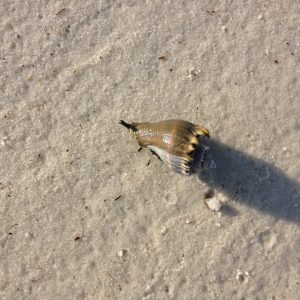In recent weeks, volunteers and I have been surveying local estuaries counting terrapins, horseshoe crabs, and monitoring seagrass. One animal that has been very visible during these surveys is the relatively large snail known as the crown conch (Melongena corona). Its shell is often found with a striped hermit crab living within, but it is actually produced by a fleshy snail, who is a predator to those slow enough for it to catch.
The shell is familiar to most who venture to the estuary side of our beaches. Reaching around five inches in length, crown conch shells are spiral with a wide aperture (opening) and brown to purple to white in color. Each whorl ends with white spins giving it the appearance of a crown and – hence – it’s common name. They are typically seen cruising along the sediments near grassbeds, salt marshes and oyster reefs – their long black siphons extended drawing in seawater for oxygen, but also to detect scents that will lead them to food.
These snails breed from winter to early summer. Females, larger than males, will develop 15-500 eggs in capsules, which they attach to hard structures within the habitat; such as wood, seagrass blades, and shell material.
Crown conchs are subtropical species and have a low tolerance for cold water. They are common in the panhandle and may expand further north along the Atlantic coast if warming trends continue. They have a higher tolerance for changes in salinity and can tolerate salinity as low as 8 ppt. The salinities within Pensacola Bay can be as low as 10 ppt and Santa Rosa Sound / Big Lagoon are typically between 20-30 ppt. The developing young require higher salinities and thus breeding takes in the lower portions of our estuaries.
These are guys are snail predators – seeking prey slow enough for them to catch. Common targets include the bivalves such as oysters and clams, but they are known to seek out other snails – like whelks. Crown conchs are known to feed on dead organisms they encounter and may be cannibalistic. As with all creatures, they have their predators as well. The large thick shell protects them from most but other snails, such as whelks and murex, are known predators of the crown conch.
These conchs tend to stay closer to shallow water (less than 3 ft.) due the large number of predators at depth. They are common in seagrass meadows and salt marshes and – if in high numbers with few competitors – have been considered an indicator of poor water quality. There is no economic market for them but they are monitored due to the fact they affect the populations of commercially important oysters and clams.

The “snorkel” is called a siphon and is used by the snail to draw water into the mantle cavity. Here it can extract oxygen and detect the scent of prey.
Photo: Franklin County Extension
It is an interesting animal, a sort of “jaws” of the snail world, and a possible candidate for a citizen science water quality monitoring project. Enjoy exploring your coastal estuaries this summer and discover some of these interesting animals.
Reference
Masterson, J. 2008. Indian River Lagoon Species Inventory: Crown Conch Melongena corona. Smithsonian Marine Station at Ft. Pierce, Florida. http://www.sms.si.edu/irlspec/Melongena_corona.htm.
- St. Joe Red Tide Claiming Terrapins - December 15, 2025
- The 2025 Snake Watch Report for the Pensacola Bay Area - December 15, 2025
- Rattlesnakes on Our Barrier Islands; Part 2 – Prey Selection - December 15, 2025

